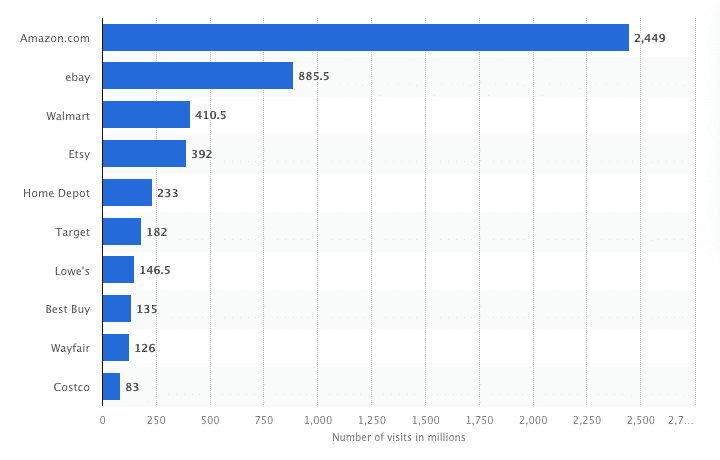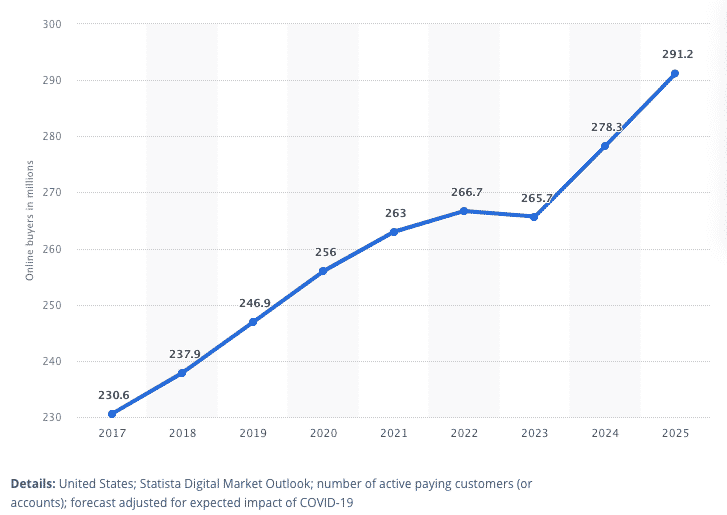When you think of ecommerce, what brands come to mind? You probably think of companies like Amazon, Walmart, and eBay—some of the most popular ecommerce retailers in the U.S. These ecommerce companies have found success both domestically and internationally, making them pretty much universally known for slingin’ online wares.

Considering the ongoing success of these companies, it should be no surprise that the United States is a notable leader in the global ecommerce industry, and the industry has proven to be extremely profitable. In August, the Census Bureau of the Department of Commerce announced the estimate of U.S. retail ecommerce sales for just the second quarter of 2021 was $225 billion — an increase of 3.3% from the first quarter.
Competition is fierce in ecommerce, and new entrants are eager for a piece of the pie. That’s why it’s critical that any ecommerce brand works hard to bump up awareness early and build an audience over time.
Many companies may opt to wait until their brand is well-established or has reached a specific revenue milestone, but the truth is that while you’re waiting for “the right time,” someone else is piquing the interest of your ideal audience.
The world of ecommerce moves fast, and we’ve all seen our fair share of overnight hits take digital shopping by storm. Even if you have no room in the budget or feel like you lack that expert prowess, building your audience is possible and necessary to gain momentum and get out of the gate before your competition. Here are three reasons why your online brand should start vying for time and space in front of more people pronto.
Why Is Audience-Building so Important For a Brand?
Remember the dilemma of the chicken and the egg? The same question can be applied to a brand. So, what came first? The audience or the brand? Without the audience, how does a brand even know what to make or who to appeal to. But without a brand, there’s no audience to appeal to!
Is that flawless logic? Not at all, but you get the gist.
The point is, most ecommerce marketers would agree that a brand exists to serve the audience—whether through an experience or to simply solve a problem or gap in the market. The Big challenge in ecommerce is to accurately identify the audience that is most likely to benefit from what a brand is selling. Many times, targeting an audience starts with identifying some key demographics. Depending on your product, your audience will often share similar characteristics or traits including:
- Location
- Gender
- Age
- Values
- Education
- Marital Status
- Career/Profession
With all the data gathering happening on apps, websites, and more these days, there’s no shortage of demographic information to build an audience-honing strategy around. As informative as this data might be, though, it’s also important to not solely focus on demographic information and decide you have your audience locked in for the rest of time.
Your target audience will continue to ebb as they get older or as the youths age into consumerism. Also, who you feel your audience is might not be your main customer. For instance, Kleenex was first advertised as a disposable makeup-removing towel for women. However, after a couple years, the company got enough feedback from customers who were actually using the tissues to blow their nose and it decided to pivot and expand its intended audience.
When you first embark on your audience-building adventure, consider factors like the ones listed above to give you a rough idea of who you imagine benefiting most from your products, but always keep an open mind. The more you fine-tune your targeting tactics, the more you’ll learn about who your audience really is. You can’t start earning the admiration and business of the perfect audience, though, if you never even start.
Three Reasons to Start Building Your Ecommerce Audience Stat
1. There are more ecommerce consumers than ever.
Ecommerce has been steadily growing since its inception, but the COVID-19 pandemic has introduced more new consumers to ecommerce than was previously forecasted for 2020.

Stay-at-home orders ultimately forced non-ecommerce users to finally take the plunge and purchase goods online—3% of US consumers shopped online for the first time since the pandemic was declared. (That may not seem like much, but that’s roughly 8 million fresh ecommerce consumers just in the US!) Many businesses have seen a surge in online purchasing as people continue to shop from home safely rather than visit a brick-and-mortar store. Plus, this trend isn’t expected to change any time soon.
This means that there is a large portion of people shopping online, right now, who haven’t pledged loyalty to any brand. These are key consumers to build into your target audience so that you can create a need for your product, wow them with the best brand experience, and earn their loyalty for the long haul.
2. There is no one-size-fits-all shopping platform for consumers.
Real estate on the internet is crowded these days, and that means your audience is searching for goods across multiple platforms. From Google to Amazon to even YouTube, online shoppers are very resourceful when it comes to discovering new brands and products to purchase.
Ecommerce brands need to consider building an audience that can be reached no matter where they’re conducting research, reading reviews, and beyond. Brand awareness doesn’t happen in one place with one tactic—extending your reach requires expanding your efforts across more than one channel.
Studies show 86% of shoppers are regularly channel-hopping across at least two channels, so you need to build an audience to capitalize on more than one channel. In addition, you need to use those channels to engage with your audience regularly, whether it is through social media or targeted advertisements.
The sooner you start finding the pockets of the internet where your bread-and-butter audience is searching and spending time, the sooner you can earn their business. Take advantage of the many channels and opportunities to engage an audience today, and own the one that resonates most with your fans.
3. Retail is continuously changing.
The traditional retail landscape has changed in the last decade. And as much as the future of retail and the impact of ecommerce was forecasted, it was all upheaved by the coronavirus pandemic. If there’s one takeaway, it’s that retail is going to be a perpetually changing entity in our everyday lives.
New technologies unfurl, new channels reveal themselves, consumer behavior endlessly adapts. Ecommerce is dynamic and there’s no better time to make your brand known than the present. People are shopping online, right now, and they’ll continue to for decades to come. Every moment that you wait to connect with an engaged audience is one that will be capitalized on by your competition.
It may feel a bit like hopping onto a moving merry-go-round, but the ride is worth the leap. When you can strike a genuine and authentic connection with people and start building a sizable audience of shoppers, your ecommerce brand will grow and scale beyond your wildest goals.
It’s Time to connect with your Ecommerce Audience
According to a 2021 Pew Research study, 85% of Americans say they go online daily. This is why audience-building is a critical first step with ecommerce. If companies sit and wait, they could miss opportunities to connect their brands to consumers.
Finding your audience can help cut through the noise so you can connect with them through brand awareness and unique experiences. Once you’ve tapped into who is buying your goods, the more opportunities present themselves. For example, you can start exploring personalization or create a loyalty program that resonates deeply. Or you can even strengthen your customer relationship by investing in social causes or programs that matter most to them.
Understanding your audience is the first step to creating those unique experiences for them. Since no two customers have the exact same journey, ecommerce marketers can customize the online journey from initial search to payment to create the ideal journey for their audience. In addition, ecommerce companies need to keep up with the needs of the audience as they change and grow. Just because you found the audience doesn’t mean you can become complacent, especially since the ecommerce industry has become more dynamic than ever before.
Now, what are you waiting for? Your audience is out there.